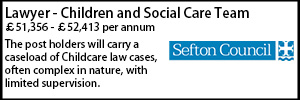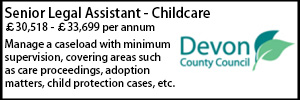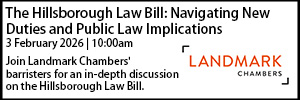Senior family judge gives "steer" on when hearings should be in-person, criticises speed of implementation of Public Law Working Group recommendations
- Details
The central theme running through the approach that should apply to whether hearings should be held in person, remotely or a hybrid is that the parties and their lawyers should normally be physically present at court on those occasions when an important decision may be taken, the President of the Family Division has suggested.
In a speech to the national conference of the Family Law Bar Association, "Interesting Times", Sir Andrew McFarlane was however keen to stress that he was only offering “a steer” and describing “the general direction of travel which courts should expect to follow, depending on the individual circumstances as they apply in each case and other local factors”.
He also criticised the inconsistent implementation of the recommendations contained in the Public Law Working Group's (PWLG's) report of April 2021, which he said should have been taken up by every local authority in England and Wales by now.
The President told the conference the stage had been reached in the playing out of the pandemic when it was possible to contemplate a gradual increase in the volume of cases that are heard in person in court, as opposed to remotely or at a hybrid hearing.
Sir Andrew confirmed that he and Lord Justice Baker (as the judge overseeing ‘recovery’ in the Family Court and the COP) would not be issuing any national guidance or practice direction on the topic. “It has been, and remains, our firm view that the circumstances around each case and each local court centre will vary to such a degree that any firm ‘black-letter’ direction or guidance would be inappropriate. The experience of the past 18 months has shown that judges and magistrates can and should be trusted to exercise their discretion on a case-by-case basis, within broad parameters, rather than being subject to unnecessarily restrictive and clunky national guidance.”
He said the primary reason for not doing so was that he continued to believe that the decision as to the format for each hearing should be taken by the judge in charge of the case, “unfettered by any prescriptive diktat from on high”.
A second factor, amongst many others, was geographical. “Whether it is necessary or proportionate to conduct an in person hearing, or a remote one, may well vary depending upon the distance from court, availability of public transport and other factors. National guidance that is unduly prescriptive might land well in the big urban conurbations, yet cause real difficulties in places such as Cornwall (where I conducted my first post-Covid court visit this week) or Cumbria.”
The President did use his FLBA speech though to set out some broad parameters within which judicial discretion will continue to be applied. “My aim is to offer a steer and to describe the general direction of travel which courts should expect to follow, depending on the individual circumstances as they apply in each case and other local factors.” [President’s emphasis]
Sir Andrew said: “No one working in the Family Court or the COP now expects a return to the status quo, in terms of working practices, that existed in February 2020. Supported by enhanced IT, the courts have now become used to remote working and, for an appropriate hearing, and there will be many, this should now be the format of choice.
“The central theme running through the approach that should apply is that the parties and their lawyers should normally be physically present at court on those occasions when an important decision may be taken.”
The President acknowledged that there were a number of positives about remote hearings, but suggested that one clear negative was the absence of that time outside court, “in the 45 minutes or so before a hearing, when the presence of ‘the court door’ and the proximity of the other parties and their lawyers will not infrequently lead to a focussing of issues or even settlement.
“That time and space simply does not exist before a remote hearing and it is important that this valuable opportunity for advice, negotiation and possible settlement is regained.”
Sir Andrew added that it was also clear that, at least some lay parties afforded less respect to the court process, and the outcome of it in terms of any order, when the hearing was online or by phone.
The President also argued that the use of remote attendance was not necessarily more efficient and quicker and it was possible to process more cases at court than it was to do so remotely.
“More generally, the obvious benefits of an attended, in court, process before a judge or magistrate makes an important decision in a family case do not need to be stated. Remote platforms are good for undertaking transactional communications, but there is more to a Family Court hearing than simply transacting business. Much that goes on has a ‘human’ perspective, which can often be lost online, but is fully present in a court room.”
He did stress though that the technology should continue to be embraced and for it to be used, for the right hearings, to the full.
A balance had to be struck in each case, but generally that balance should come down in favour of the parties and their lawyers attending all hearings where an important decision in the case may be taken, the Family President said.
In public law children cases, the hearings where an important decision may be made are likely to include the first CMH, ICO hearings, the IRH and final hearings. A straightforward directions or case management hearing was likely to be appropriate for a remote hearing.
In relation to appeals he said that whilst an important decision would normally be taken at the end of an appeal hearing, the question of whether an appeal was heard remotely or in person might turn upon the issues to be raised and whether both parties were represented or in person. “The format of an appeal hearing is therefore a matter for judicial discretion in each case.”
The President said there was a common view that it was beneficial – “in many cases it is indeed an improvement” – for expert evidence to be given remotely and, subject to individual factors in any particular case, this was now likely to be the default position.
In the speech he accepted that CAFCASS and local authority social services were currently under extreme pressure in marshalling sufficient resources to cover the volume of work. “I anticipate that judges and magistrates will take these matters into account when deciding whether a CAFCASS officer or local authority social worker should attend an in-person hearing remotely and, if so, whether they need to attend for all or only part of it.”
He added that when deciding whether or not to hear a case remotely, judges and magistrates should take account of health related issues raised by a party or professional. “Such issues may not be determinative in the choice of format, but must be taken into account in the exercise of judicial discretion.”
In his speech the President also covered the recommendations in the main report of the PWLG under the chairmanship of Mr Justice Keehan that Sir Andrew said had been launched with the firm expectation that they should be taken up by every local authority in England and Wales by now.
“The speed and commitment to training, and the full implementation of the recommendations, at present varies from region to region and court centre to court centre. It is imperative that all local authorities and all courts adopt these measures in full. The aim is to ensure that cases only come to court when they need to do so and when they are ready to do so in terms of assessments and all other necessary evidence.”
Whilst in the period since the launch in April the number of s 31 applications received by the court had shown a consistent drop of around 12% month-on-month compared to last year, it was too early to say whether this drop was a direct result of the PLWG recommendations, or was consequent upon there being a drop in referrals and new cases that had been seen by most local authorities over the same period, he said.
Sir Andrew also noted that the PWLG Supervision Order sub-group was continuing its work. “The big question of whether there is a case for the abolition, or replacement, of supervision orders has been referred to the Law Commission. The sub-group’s deliberations are focussed upon making supervision orders more robust and effective.”
A final report on this topic, which is expected by April 2022, will include draft Best Practice Guidance. Another sub-group on Adoption has meanwhile started work with a final report expected later in 2022.
The President meanwhile said the Family Public Law digital programme was now fully operational in 10 of the 43 care centres. Between 10 and 12 further centres will become fully operational next week and it was envisaged that all other centres would join them before the end of the year.
“The benefits of FPL have always been clear to me and I am confident that we will look back in time to come at the regime of paper-based care applications with some astonishment that it endured for so long.”
Sir Andrew accepted that taking up and implementing a substantial new software programme had not been without difficulties, which had been made no easier by doing so during the pandemic when all involved were working beyond their ordinary capacity. “After a difficult time, I am heartened by positive reports from some of the trail-blazing courts and I am very appreciative of all the hard work that everyone, but particularly the team at HMCTS, have put in to make this project a success.”
He added: “I fully realise that for local authority lawyers and the legal profession it is an unwelcome additional burden to be expected to learn about and engage with the new digital process at a time when all are working at full stretch for other reasons. The aim of digitisation is to make life easier and more efficient for one and all in the long-run, and I am very grateful for the patience and tolerance of those who have taken up the scheme thus far for doing so.”
The President also mentioned that HMCTS had, for some time, been developing a Video Hearings Service (VHS) for use in all family and civil courts and tribunals; this had been in production since long before the pandemic. CVP was a ‘quick fix’ which was devised urgently by HMCTS to meet the court’s needs when the Covid struck, he suggested.
The VHS pilot in Birmingham had been demonstrating many benefits over and above CVP and Teams but was also exposing vulnerabilities which were now being ironed out. It also required some refinement/improvement, and needed to demonstrate greater stability. However, when HMCTS and the Judiciary were satisfied that it had reached a reliable level of performance it would be rolled out more widely.
“It is a more sophisticated product than CVP, and in the way in which it replicates the court experience for judge, lawyer, and litigant more faithfully, it is superior to Teams. It is intended that VHS will in due course replace the use of both current systems.”
In his speech Sir Andrew also said:
- He expects later this month to publish his conclusions following the ‘Transparency Review’.
- His concern for the well being of all those who work in the Family Court of the CoP remains very high. “The system is currently running ‘hot’ and at a level above its normal capacity.” The number of judicial sitting days was up by about 25%, but the rate at which cases are concluded is down and the backlog of work in the system remains “stubbornly high”. The scale of the backlog was such that delay was inevitable.
- Practitioners can expect that from now on courts will be more insistent on compliance with deadlines for delivering documents. “A return to a more timely and orderly process is in the interests of one and all, and I am therefore looking to the judges to be more robust on this issue from now on.”
- The task of drafting orders after a hearing had become much more substantial and protracted process than was hitherto the case. He hoped that a practice direction may be issued early next year.
A copy of the speech can be viewed here.























































